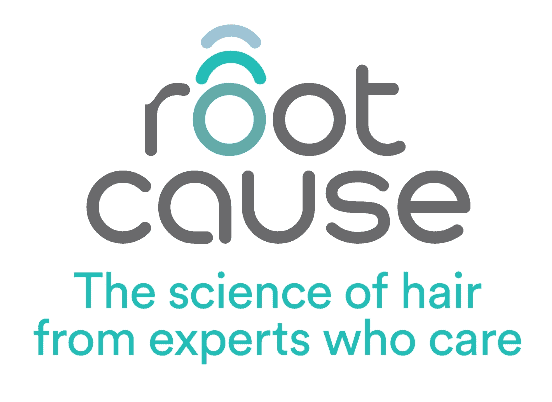Trichological Dangers of Being Black
03.11.23
Almost anybody can be afflicted by any scalp or hair condition, but certain conditions, including hair loss, are more prevalent in darker skin tones and afro-textured hair types than in others. We hear from Jacky van Driel on a subject she is incredibly passionate about.

The fact that dermatology is one of the medical fields which suffers the most from racial bias [1] puts trichology at a high risk of suffering the same fate. This racial bias is inevitably multifactorial, but from my experience, not understanding the differences between caucasian skin/hair and black skin/hair is one of the major contributing factors.
What are these differences?
As it has always been quite clear that different ethnic groups present with different hair types, and even clearer that most haircare products that were on the market were targeted at straight hair, a need for hair types classification arose on a more commercial level.
Afro-textured hair consumers started to want easier access to products that worked on their hair, a demand was created, and a new hair cosmetics niche was founded. As curly hair products started to make an appearance on the shelves, it became obvious that they did not suit all curl types or textures and a need for hair type categorisation arose.
The shape of the hair follicle affects the way the cortical cells are arranged inside the cortex of the hair fibre, which is what gives rise to how straight, wavy or curly the hair fibres are.
African hair’s curliness is due to the ‘flatter’ hair follicle shape, which affects the way these cortical cells are arranged inside the cortex. The flatter or more elliptical the hair follicle is, the curlier the hair strands will be.
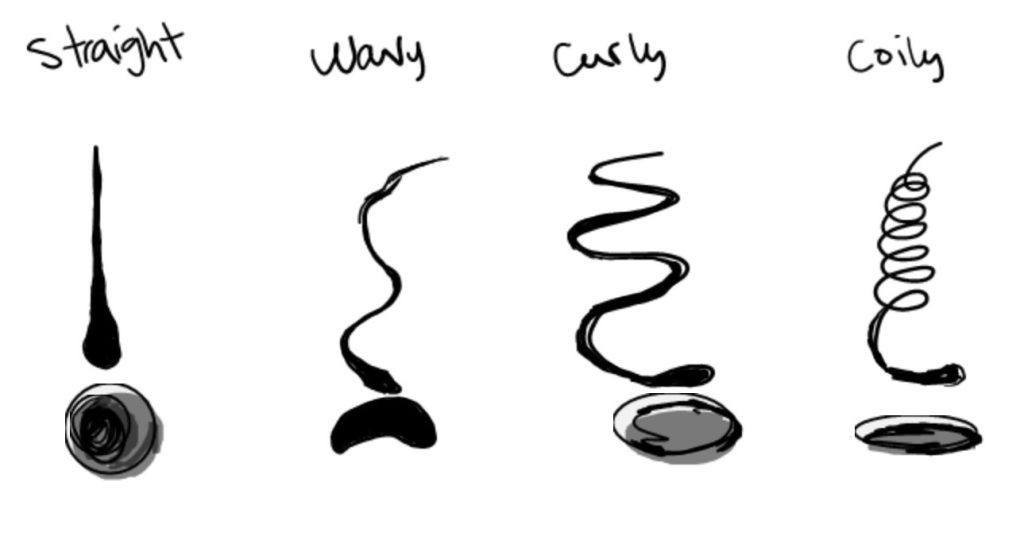
Numerous systems have been developed in an attempt to categorise hair into various types, one of the more popular systems being that of renowned celebrity hair stylist Andre Walker whose classification of hair types started the categorisation in terms of hair curliness. Researcher Ali N. Syed, Ph.D. and his team at Avlon Industries, Inc., have now proposed a ‘Periodic Table of Global Textures’ classification system which takes into account the curliness of the hair [2], but other important hair properties such as those listed below must also be considered.

Type 1: 1A, 1B, 1C
These hair types are typically observed in Caucasian/Northern European, Oriental/Asian and American-Indian populations.
They tend to be completely straight with no curl diameter at all, no curvature, no waves.
The hair fibres exhibit high tensile strength.
Type 2: 2A, 2B, 2C
These hair types are predominantly found in North America, Latin America, Europe, the Middle East, Southeast and East Asia, and North Africa.
The hair is typically straight and shows some degree of waviness when dry (appearing straight when wet). Neither a curl diameter nor curvature is usually found, and the fibres also exhibit high tensile strength. Having said that, most Europeans’ hair types fall within this category with approximately 45% being straight hair, 40% wavy hair, and 15% curly hair [3].
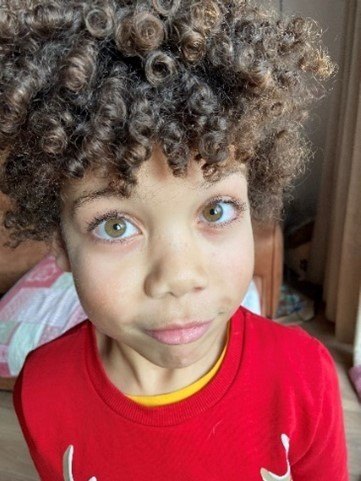
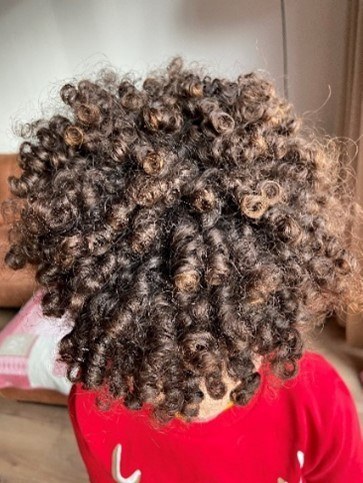
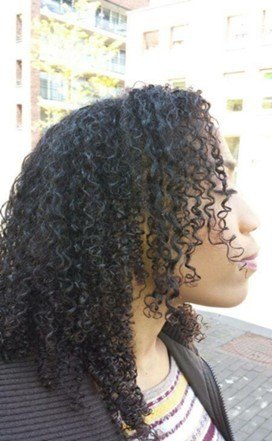
Type 4: 4A, 4B, 4C
This is a category mostly seen in Africans, African Americans in the US, the Caribbean, and in countries with a high black population like Brazil.
These hair types show intense curliness or coiling. The hair fibres have a small curl diameter, very high curvature, and curl index. The fibre tensile strength is significantly lower than in types 1, 2 and 3.


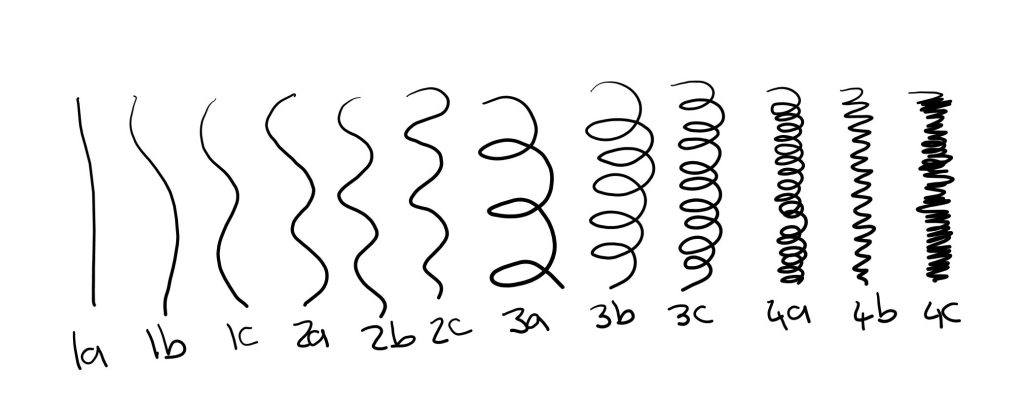
Prevalence of certain scalp and hair loss conditions in darker skin and afro-textured hair individuals
Even though the need for hair types categorisation first arose for cosmetic and aesthetic purposes, observations of structural and mechanical differences were made in afro-textured hair when compared to straight hair types.
Some studies suggest African-coily hair has a greater amount of low sulphur-protein than high sulphur-protein compared to what is observed in hair from Asian or Caucasian individuals. These studies are not conclusive.
Other studies have also shown that despite all the above-mentioned physical differences between hair types, the amino acid makeup of the proteins in hair (the keratins) is rather uniform [6]. Lipid composition of Afro-textured hair has been a little more difficult to elucidate, some studies disagreeing on whether sebaceous glands in African descendants are as active as in other racial groups, with one study by Gavazzoni Dias in 2015 asserting that they are in fact less active in African descendants, but that people with afro or curly hair are more likely to have oilier scalps but with less oil on the hair fibres due to the higher twist ratio (compared to straight hair).
What we do know is that in general, curly-coily hair types when compared to types 1 and 2, are more prone to breakage, are less elastic, and the scalp is dryer and more prone to fungal and bacterial colonisation, making it more susceptible to conditions such as seborrhoeic dermatitis, dissecting cellulitis, acne keloidalis nuchae, and CCCA (central centrifugal cicatricial alopecia) amongst others [4]
Type 4 Curly-coily hair when compared to other hair types (1, 2 and 3) is more prone to trichorrhexis nodosa, which is a condition characterised by hair breakage. This breakage is due to weak points along the hair shaft and is either inherited, or more commonly acquired from physical or chemical trauma to the hair.
Another hair shaft condition afro hair is more prone to is trichonodosis, a condition whereby the hair shaft forms a knot on itself, colloquially known as ‘fairy knots’ or ‘single strand knots’. The hair fibres also easily intertwine with each other, forming bigger knots. This makes combing difficult, requiring more force, leading to more breakage.
Afro hair is also more porous, usually contains less moisture and is less able to retain moisture than straight and wavy hair types. The twists/kinks in the hair shaft, coupled with its inherent dryness, makes African hair more prone to breakage [5].
It’s important to understand these differences between hair types as they impact treatment options for these conditions when they occur on darker skin (scalp) and textured hair. We shall discuss this in a moment.
Why is it important to understand the differences between hair types?
Trichologists with more comprehensive training will understand the ways in which Afro-textured hair biologically and structurally differs from Caucasian and Asian hair and will be able to mitigate side effects of potentially drying scalp and hair treatments.
A common example is the use of medicated shampoos such as 2% prescription ketoconazole shampoo used for conditions such as seborrhoeic dermatitis and psoriasis. It is drying for any hair type following long term usage, but it is particularly drying on Afro-textured hair and much sooner too, due to its structural properties.
A well-trained trichologist would understand that advising clients with type 4 hair to use 2% ketoconazole shampoo three times per week will almost undoubtedly lead to hair breakage and will mitigate this by recommending a hair care routine which will allow for more moisture, conditioning agents and emollients to be reintroduced into the hair.
Another important point for trichologists to understand is what a typical hair care routine involves for their types 3 and 4 clients. It usually demands more time, more products and more patience. It also usually involves protective styling, which the client may need help with (to minimise damage) and might be unwilling to take out before at least 1 to 6 weeks to be able to comply with a treatment plan. This also helps in being able to isolate causative or aggravating factors for some scalp and hair loss conditions such as CCCA.
We will discuss central centrifugal cicatricial alopecia in more detail in an upcoming article.
So, what should you do if you have a darker skin tone, curly or afro-textured hair and are experiencing hair loss or a scalp problem?
The first thing I would advise is to not ignore your symptoms, which could be itching, pain, tingling or even a burning sensation. If you notice flakes, discolouration on your scalp, hair breakage or hair thinning, immediately seek the help of a trichologist or dermatologist.
The second step would be to search for a trichologist/ dermatologist who has some training or experience or with darker skin tones and curly or afro-textured hair. A practitioner being black or having textured hair themselves does not guarantee knowledge and understanding of dark scalp and textured hair conditions (you can read our article on Racial Bias here).
If you want to discuss your hair loss or scalp condition with a trusted trichologist, book an online trichology consultation with us – we ensure our practitioners are educated in clients who have darker skin tones and curly or afro-textured hair.
Thanks to Jacky van Driel for her training and expertise.
References:
- Wilson BN, Murase JE, Sliwka D, Botto N. Bridging racial differences in the clinical encounter: How implicit bias and stereotype threat contribute to health care disparities in the dermatology clinic. Int J Womens Dermatol. 2021 Jan 9;7(2):139-144. doi: 10.1016/j.ijwd.2020.12.013. PMID: 33937479; PMCID: PMC8072500.
- Texture Talk: Reinforcing Curly Hair Health. Ali N. Syed, Ph.D., Maliha N. Syed, Ph.D. and Jasmine Mathew, Avlon Industries, Inc., Melrose Park, IL USA, Cosmeticsandtoiletries.com. Jan 31st, 2022
- Westgate, G.E.; Botchkareva, N.V.; Tobin, D.J. The Biology of Hair Diversity. Int. J. Cosmet. Sci. 2013, 35, 329–336.
- (Lindsey SF, Tosti A. Ethnic hair disorders. Curr Probl Dermatol. 2015;47:139-49. doi: 10.1159/000369414. Epub 2015 Feb 20. PMID: 26370652)
- Porter CE, Diridollou S, Barbosa VH. The influence of African-American hair’s curl pattern on its mechanical properties. Int J Dermatol 2005;44 Suppl 1:4–5.
- Franbourg, A.; Hallegot, P.; Baltenneck, F.; Toutain, C.; Leroy, F. Current research on ethnic hair. J. Am. Acad. Dermatol. 2003, 48, S115–S119.
- Malki L, Sarig O, Romano MT, Méchin MC, Peled A, Pavlovsky M, Warshauer E, Samuelov L, Uwakwe L, Briskin V, Mohamad J, Gat A, Isakov O, Rabinowitz T, Shomron N, Adir N, Simon M, McMichael A, Dlova NC, Betz RC, Sprecher E. Variant PADI3 in Central Centrifugal Cicatricial Alopecia. N Engl J Med. 2019 Feb 28;380(9):833-841. doi: 10.1056/NEJMoa1816614. Epub 2019 Feb 13. PMID: 30763140.
